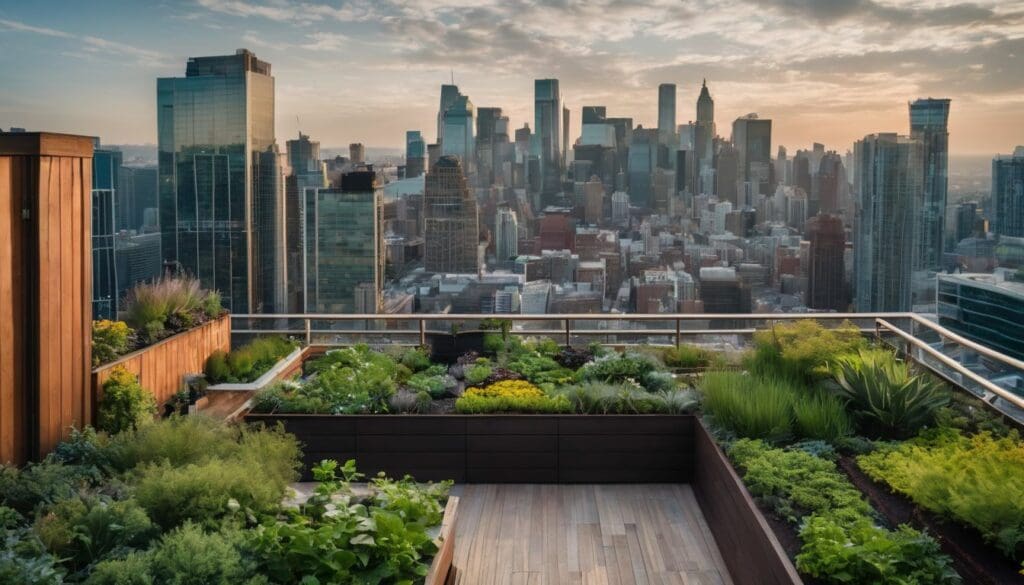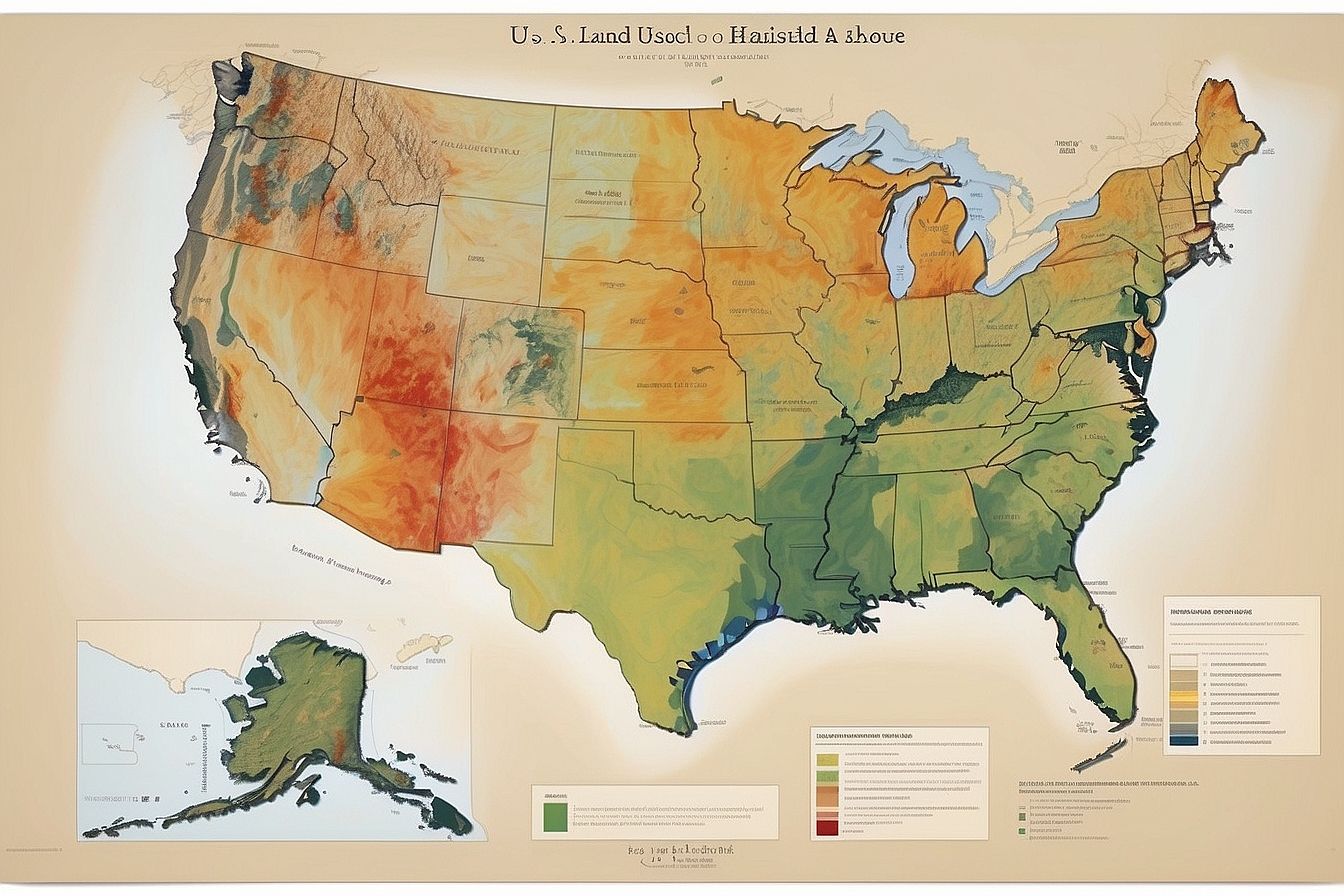As our cities expand, the concrete expanse grows with them, often leaving us pining for a glimpse of verdant hues amid the urban grey. It’s a sentiment many share as we witness the relentless march of urban development encroaching upon Mother Nature’s domain.
Research is firmly on our side; green roofs are championing the cause with figures to show they can cut energy consumption by an impressive 75%. This offers much-needed solace in our quest for sustainable living.
Our comprehensive analysis on green rooftops is teeming with practical tips to weave these ecological havens into the fabric of our city life. So stay tuned – there’s a whole lot more green wisdom coming your way!
Key Takeaways
- Green roofs slash energy bills by providing natural insulation, keeping buildings cooler in summer and warmer in winter, which can cut energy consumption by up to 75%.
- The presence of green roofs in urban areas has been shown to increase property values because they offer attractive eco-friendly features that appeal to homebuyers and renters.
- By absorbing rainwater, green roofs ease the strain on city drainage systems during heavy rainfall, reducing the risk of flooding and water pollution.
- Green rooftops combat the urban heat island effect by reflecting sunlight and providing shade, leading to cooler city environments and less reliance on air conditioning.
- These ecological havens boost biodiversity in cities, offer residents access to natural spaces for improved well-being, and provide opportunities for local food production through urban agriculture.
Economic Benefits of Green Roofs in Urban Environments
Green roofs in urban environments provide several economic benefits. They can help lower energy costs, increase property values, and offer greater durability with less frequent roof replacement.
Lower energy costs
Green roofs play a crucial role in slashing energy bills. By adding a layer of natural insulation, they keep buildings cooler in summer and warmer in winter, reducing the need for air conditioning and heating.
They act as excellent temperature regulators, absorbing heat during hot days while retaining warmth when it’s cold out. This thermal regulation translates into real savings on our energy costs.
We enjoy these economic benefits without compromising rooftop durability or aesthetic appeal. Sustainable roofing like this is not just about cost-saving; it’s also about investing in the future of urban environments.
Next, let’s explore how green roofs can elevate property values and enhance the overall value of urban spaces.
Increased property values
Green roofs can significantly enhance property values by providing an attractive and eco-friendly feature that appeals to environmentally conscious buyers. The addition of a green roof often leads to increased interest from potential homebuyers, translating into higher selling prices in urban areas with limited green spaces.
Incorporating rooftop gardens and green infrastructure aligns with the growing trend towards sustainable living, making properties more desirable in today’s eco-aware market.
Moreover, the installation of green roofs showcases a commitment to environmental responsibility, which is becoming increasingly important for both business and residential properties.
Greater durability and less frequent roof replacement
With increased property values, it’s important to consider the longevity and durability of green roofs. Green roofs provide a protective layer that shields the underlying roof membrane from harsh weather conditions, such as extreme temperatures and UV radiation.
This protection extends the lifespan of rooftops, reducing the frequency of replacements and maintenance costs. Additionally, the vegetation on green roofs acts as a natural insulation layer, slowing down temperature fluctuations that can cause materials to degrade over time.
Green roofs significantly contribute to sustainable urban development by offering long-term cost savings through their enhanced durability and reduced need for frequent roof replacement.
Environmental Benefits of Green Roofs in Urban Environments
Green roofs help improve stormwater management by reducing the amount of runoff and providing a natural rainwater buffer. They also play a significant role in reducing the urban heat island effect and improving air quality through their air purification properties.
Improved stormwater management
Green roofs significantly help manage stormwater in urban environments. By absorbing rainwater, they reduce the strain on drainage systems and prevent flooding in cities. When it rains, green roofs act as a sponge, capturing water and releasing it slowly over time.
This not only reduces the risk of overflow but also filters pollutants from the water, preventing harmful substances from entering our waterways.
Installing green roofs supports sustainable urban planning by providing a natural solution to stormwater management. Rather than directing rainwater straight into drains where it can overwhelm sewer systems and cause pollution, green roofs allow for efficient rainwater buffering and purification processes that benefit both the environment and communities.
Reduction of urban heat island effect
Green roofs help reduce the urban heat island effect by absorbing and retaining less heat than traditional roofs. This can lower temperatures in urban areas, making cities more comfortable to live in during hot weather.
By decreasing the demand for air conditioning, green roofs also reduce energy consumption and greenhouse gas emissions.
The vegetation on green roofs provides shade and evaporative cooling, effectively mitigating the impact of urban development on local microclimates. Additionally, green roofs contribute to the overall improvement of air quality by trapping pollutants and filtering airborne particulates.
Improved air quality
Reducing the urban heat island effect with green roofs also contributes to improved air quality. By trapping and filtering airborne pollutants, green roofs help in lowering particulate matter and harmful gases, promoting cleaner and healthier air for everyone.
These eco-friendly rooftops effectively absorb carbon dioxide, while simultaneously emitting oxygen, leading to a more breathable urban environment.
Green roofs play a vital role in reducing pollution levels within cities, benefiting both human health and the overall ecosystem. The presence of these living structures promotes sustainable architecture that actively supports environmental conservation efforts in our communities.
Social Benefits of Green Roofs in Urban Environments
Green roofs promote increased biodiversity, which can enhance urban ecosystems and provide valuable habitat for wildlife. To learn more about the social benefits of green roofs in urban environments, keep reading our blog!
Increased biodiversity
Green roofs contribute to increased biodiversity by providing habitats for birds, bees, butterflies, and other wildlife. The variety of plants on green roofs attract diverse species, promoting a healthier and more balanced urban ecosystem.
These biodiverse urban landscapes not only enhance the visual appeal of the city but also play a vital role in supporting local flora and fauna.
Moreover, promoting urban biodiversity through eco-friendly roofs fosters awareness about the importance of conservation and environmental sustainability among city dwellers. It encourages communities to value their natural surroundings and promotes a sense of responsibility towards protecting the environment for future generations.
Improved health and well-being
Green roofs contribute to improved health and well-being by providing natural spaces for relaxation and recreation in urban environments. These green spaces offer opportunities for physical activity, reducing the risk of sedentary lifestyles and associated health issues.
Furthermore, the presence of plants on rooftops can help reduce stress and improve mental well-being by creating calming and aesthetically pleasing environments. Additionally, green roofs promote better air quality by filtering pollutants and carbon dioxide, creating a healthier living environment for residents in urban areas.
The integration of green roofs also encourages community engagement through educational programs about sustainable living and environmental conservation. This presents an opportunity for individuals to learn about the benefits of eco-friendly practices while participating in activities such as urban agriculture or gardening initiatives on rooftop spaces.
Urban agriculture and educational opportunities
Green roofs provide opportunities for urban agriculture, allowing for the cultivation of plants and food in city environments. This not only increases access to fresh produce but also creates educational opportunities for communities. The benefits include:
- Engaging local communities in sustainable food production.
- Teaching children about plant growth, nutrition, and environmental stewardship.
- Providing hands – on learning experiences for schools and community groups.
- Encouraging healthy eating habits and food awareness.
Conclusion
In conclusion, green roofs in urban environments offer numerous economic benefits. They lower energy costs, increase property values, and require less frequent roof replacement. Furthermore, they provide environmental advantages by improving stormwater management, reducing the urban heat island effect, and enhancing air quality.
Additionally, social benefits include increased biodiversity, improved health and well-being of residents, as well as opportunities for urban agriculture and education.
FAQs
1. What are green roofs and how do they benefit urban environments?
Green roofs are eco-friendly roofs covered with plants, which improve urban green infrastructure, offering benefits like better temperature regulation and increased roof durability.
2. Can installing a green roof on my building save energy?
Yes, by choosing a green building design that includes an energy-efficient roofing system like a green roof, you can lower the amount of energy needed for heating or cooling your building.
3. Do green roofs help with climate adaptation in cities?
Absolutely! Green roofs play a significant role in climate adaptation for urban areas by helping to manage rainwater and reduce heat absorption.
4. Are there any environmental benefits to having a green roof?
Certainly! Environmental benefits of rooftops include providing habitats for wildlife, reducing air pollution, and contributing overall to the sustainability of green buildings.





